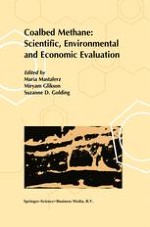1999 | OriginalPaper | Buchkapitel
Modelling of Petroleum Formation Associated with Heat Transfer due to Hydrodynamic Processes
Hydrodynamic heat transfer enables rapid petroleum formation
verfasst von : R. H. Bruce, M. F. Middleton, P. Holyland, D. Loewenthal, I. Bruner
Erschienen in: Coalbed Methane: Scientific, Environmental and Economic Evaluation
Verlag: Springer Netherlands
Enthalten in: Professional Book Archive
Aktivieren Sie unsere intelligente Suche, um passende Fachinhalte oder Patente zu finden.
Wählen Sie Textabschnitte aus um mit Künstlicher Intelligenz passenden Patente zu finden. powered by
Markieren Sie Textabschnitte, um KI-gestützt weitere passende Inhalte zu finden. powered by
This paper presents the results of modelling the formation of petroleum in the framework of rapid hydrodynamic processes in sedimentary basins. The study is motivated by the observation that many Pb-Zn deposits occur within hydrocarbon prone sedimentary basins, and that expulsion of hot basinal brines, over a geologically short period, may contribute significantly to the generation of hydrocarbons. Modelling of the generation of bitumen by hydrous pyrolysis shows that peak generation can occur after approximately 1000 years at a temperature of 200 °C. Hydrothermal modelling of advective heat transfer in a shaly formation above a hot porous layer, that permits (relatively) rapid fluid flow, was carried out. The results of this modelling indicated that with advective flow velocities in the vicinity of 0.315 m/yr (which is a reasonable value within the petrophysical constraints of the model) can significantly alter the temperature at a distance of some 200 m above the hot layer after 1000 years. It is concluded that a source bed approximately 200 m above such a hot layer, and buried 3 km deep within a basin, can attain 200 °C, and thus peak generation, in the vicinity of 1000 years.
